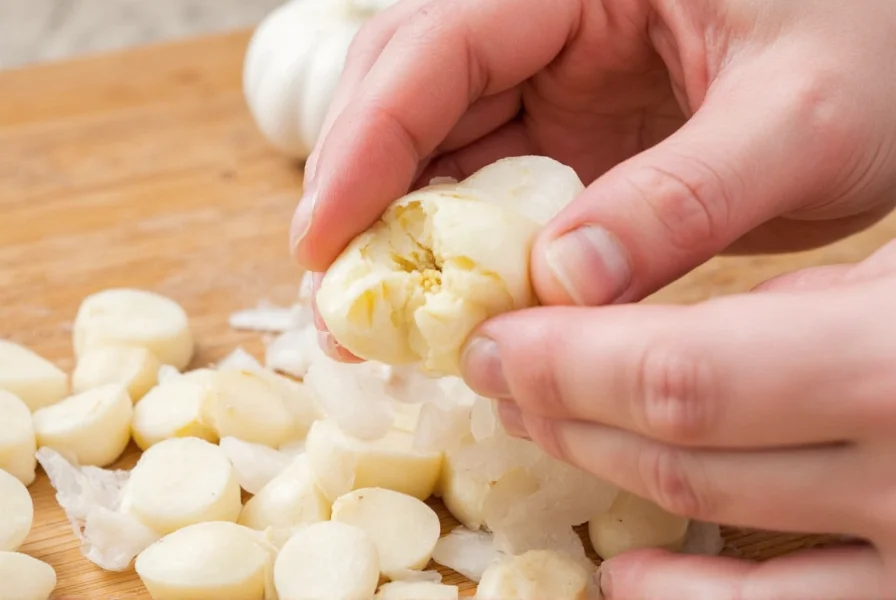Properly minced garlic releases maximum flavor into your dishes, but many home cooks struggle with this fundamental kitchen technique. Whether you're preparing a simple pasta sauce or an elaborate curry, knowing how to mince garlic cloves effectively can transform your cooking from good to exceptional.
Why Proper Garlic Mincing Matters
When you mince garlic, you're breaking cell walls that release allicin—the compound responsible for garlic's distinctive flavor and health benefits. The finer your mince, the more surface area exposed, and the more flavor infuses into your dish. Coarsely chopped garlic creates uneven flavor distribution and can burn easily, while properly minced garlic distributes evenly and cooks consistently.
Traditional Knife Method: Step-by-Step
The knife method gives you the most control and produces the best texture for most recipes. Here's how professional chefs mince garlic:
- Separate a clove from the garlic bulb
- Place the clove on your cutting board and lay the flat side of your knife over it
- Firmly press down to loosen the skin
- Remove the skin and trim the root end
- Cut the clove lengthwise into thin slices
- Sprinkle a pinch of salt over the slices (this acts as an abrasive)
- Gather slices and rock your knife back and forth until finely minced
This technique, known as "rock chopping," ensures even mincing without turning garlic into a paste. The salt helps absorb moisture and prevents the garlic from sticking to your knife.
| Method | Best For | Texture Result | Time Required |
|---|---|---|---|
| Knife method | Sauces, stir-fries, marinades | Fine, even pieces | 1-2 minutes |
| Garlic press | Salad dressings, soups | Paste-like consistency | 30 seconds |
| Food processor | Large batches, pesto | Uniform but slightly wet | 2-3 minutes |
Alternative Mincing Methods
While the knife method produces the best results for most applications, these alternatives work well in specific situations:
Garlic Press Technique
For those with limited hand strength or when preparing dressings that require completely smooth garlic incorporation:
- Peel the garlic clove completely
- Cut off the root end to create a flat surface
- Place the clove in the press chamber
- Squeeze handles firmly until garlic extrudes through holes
Pro tip: Place a small bowl under the press to catch the minced garlic, and immediately transfer it to your dish to prevent oxidation and bitter flavors.
Food Processor Method
When mincing large quantities of garlic:
- Peel multiple cloves
- Add to food processor with 1/4 teaspoon of salt
- Pulse 5-6 times until finely minced
- Scrape down sides and pulse once more if needed
Avoid over-processing which creates garlic paste that can become bitter when cooked.

Common Mistakes to Avoid
Even experienced cooks make these garlic mincing errors:
- Skipping the salt: Salt absorbs moisture and prevents sticking while helping break down fibers
- Using a dull knife: A sharp knife creates cleaner cuts without bruising the garlic
- Over-mincing: Too fine can turn garlic bitter when cooked
- Not removing the germ: The green sprout in older cloves can be bitter
Storing Minced Garlic
Freshly minced garlic loses potency quickly. For best results:
- Use immediately for maximum flavor impact
- If storing, place in an airtight container with a thin layer of olive oil
- Refrigerate for up to 3 days (longer storage diminishes flavor)
- Never store minced garlic in oil at room temperature due to botulism risk
For meal prep, consider freezing minced garlic in ice cube trays with oil, then transferring to freezer bags for up to 3 months.

Advanced Tips for Perfect Garlic Every Time
Professional chefs use these techniques to maximize garlic flavor:
- Let it rest: After mincing, let garlic sit for 10 minutes before cooking to allow full flavor development
- Temperature matters: Add minced garlic to cold oil, then heat gradually for more nuanced flavor
- Size consistency: Uniform pieces ensure even cooking and flavor distribution
- Batch processing: Mince all garlic at once rather than adding incrementally to maintain consistency
Frequently Asked Questions
What's the difference between minced and chopped garlic?
Minced garlic is cut into very fine pieces (about 1/16 inch), while chopped garlic is coarser (about 1/8 to 1/4 inch). Minced garlic distributes flavor more evenly and cooks faster, making it ideal for sauces and dressings, while chopped works better for dishes where you want distinct garlic pieces.
How can I mince garlic without it sticking to my knife?
Sprinkle a pinch of salt over the garlic slices before mincing. The salt absorbs moisture and acts as an abrasive. Alternatively, dip your knife blade in cold water between chops, or use a sharp knife as dull blades are more likely to cause sticking.
Why does my minced garlic sometimes turn bitter?
Bitterness occurs when garlic is over-processed into a paste, exposed to high heat too quickly, or contains the green germ in the center of the clove. Always remove the green sprout from older cloves, avoid over-mincing, and add garlic to already-warmed (not scorching hot) oil to prevent bitterness.
Can I use a garlic press instead of mincing by hand?
Yes, but with caveats. A garlic press creates a paste-like consistency that works well for dressings and soups but can become bitter when cooked. For most sautéed dishes, hand-minced garlic provides better texture control and flavor development. If using a press, immediately transfer the garlic to your dish to prevent oxidation.
How fine should garlic be minced for different dishes?
For sauces and dressings, mince garlic as fine as possible. For stir-fries and sautés, a medium-fine mince (about 1/16 inch) works best. For roasts or whole-ingredient dishes, coarser pieces are preferable. The finer the mince, the more quickly the garlic flavor infuses but also the faster it can burn during cooking.










 浙公网安备
33010002000092号
浙公网安备
33010002000092号 浙B2-20120091-4
浙B2-20120091-4